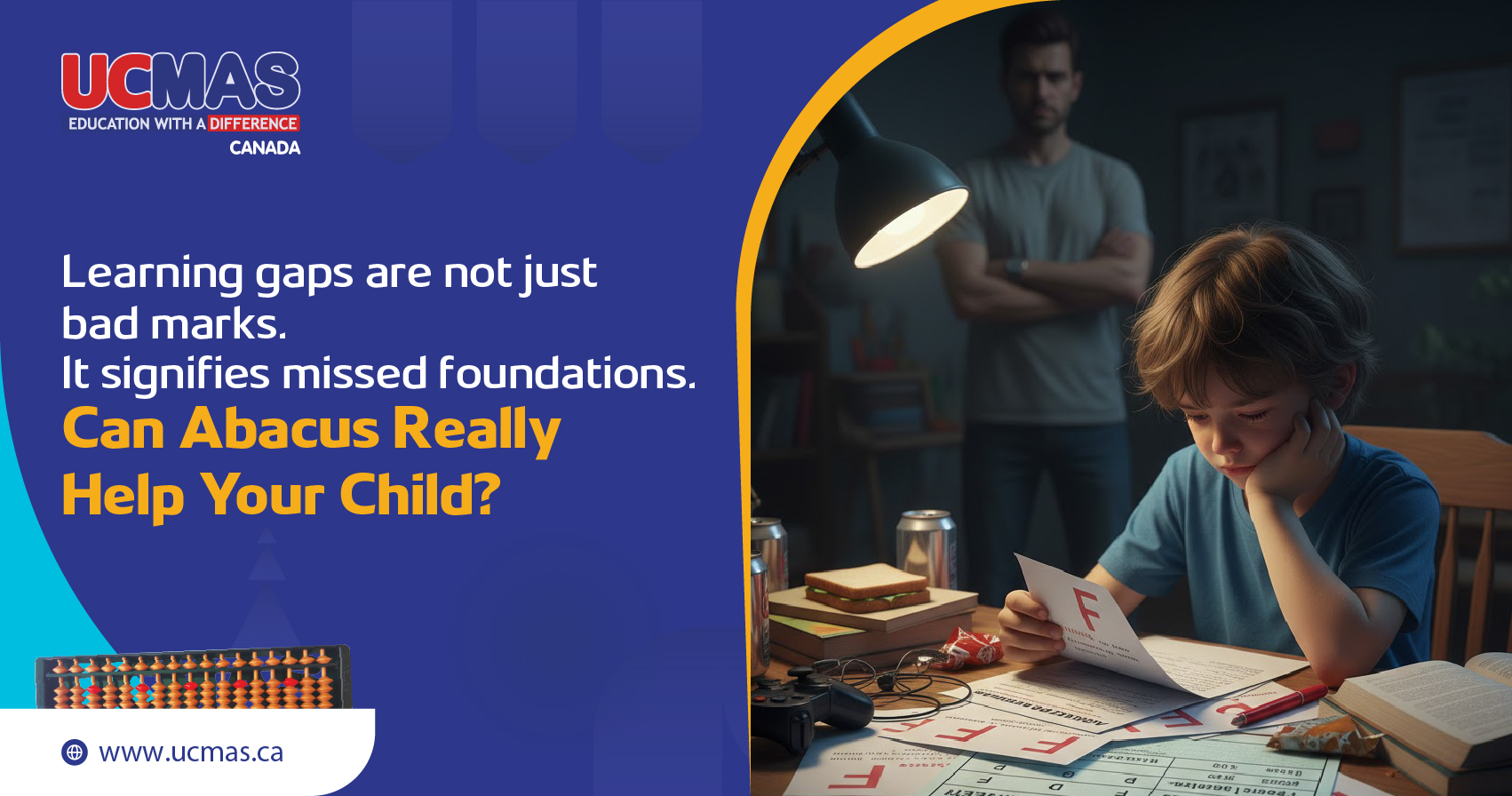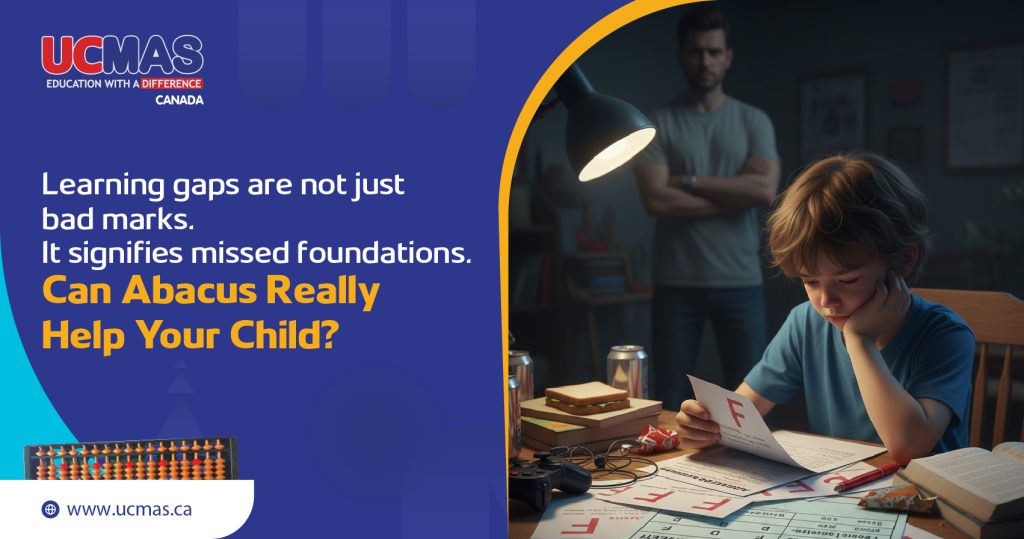
Parents don’t usually notice a “learning gap” the moment it starts. It never looks like a sudden fall. It looks like something small, a child taking longer to finish homework, avoiding math worksheets, guessing instead of thinking, copying answers from friends, or asking you to “tell them the answer” instead of trying.
Then one day in Grade 4 or 5, a teacher says something like: “He seems to be behind the class in basics.” And that’s when it hits, the gap didn’t start today. It silently built over months or years. This blog is for parents who are asking: Can something actually close that gap, or do children just learn to live with it? And more specifically: Can Abacus Math Programs help close it in a realistic, measurable way?

What Exactly Is a Learning Gap?
A learning gap isn’t about intelligence. It isn’t even about bad teaching. It is the delay between what a child should be able to do at a certain grade level versus what they can currently do. The dangerous part is that these gaps hide inside the mind long before they show in marks.
Learning gaps typically form when one stage of learning is rushed or skipped. A child who never mastered single-digit addition begins to struggle with arithmetic later. A child who never understood the logic behind multiplication becomes fearful of word problems. A child who memorized answers but never internalized concepts “crashes” when the question changes even slightly. Learning gaps are like cracks under the flooring, invisible until the floor collapses.
Why Traditional Practice Can’t Always Fix Learning Gaps
When parents notice that gap, the first reflex is: Let’s do more worksheets, more tuition, more revision. But practice does not fix a foundation that was never built. You cannot fix a conceptual delay with repetition. That is like painting a wall with a crack; you hide it for a bit, but you didn’t rebuild it.
That is where parents start looking for something that doesn’t just teach school content, but actually restructures how the brain processes numbers, not for marks, but for cognition. That is where abacus mental math enters the conversation.
How Abacus Math Helps Close Learning Gaps at the Root
Abacus classes are not “another version of tuition.” They do the opposite of tuition; they rewind the mind to where the gap originally formed and rebuild thinking from there.
An abacus-trained child is not merely doing math; they are visualizing numbers, holding steps in working memory, processing faster, and thinking logically without depending on written steps. UCMAS calls this Abacus Intelligence, a type of Abacus training that impacts the working memory and focus in a structured way. This ensures that the learning gaps in children don’t just shrink; but they stop reappearing altogether.
Mental Math Training Changes How the Brain Solves
As parents, we often question whether Abacus training is even worth it in today’s world, which is driven by AI. Moreover, their schools are already teaching them math.
But there is a crucial difference. Schools say: “Here is a question, solve it.” Abacus training says, “Here is a mind that can solve any question.”
An abacus makes your child capable of mentally processing numbers; they no longer lag in classrooms because learning is no longer burdened by fear, delay, or hesitation. Gaps close because the brain stops leaking information.

Why Abacus Training Works Even When Gaps Are “Old”
Parents often think: “Isn’t it too late now? The gap formed years ago.” But cognitive training is not time-bound. Abacus intelligence is backed by science, and neuroplasticity allows the brain to rebuild connections at any stage. Therefore, abacus training teaches the brain to compute, store, visualize, and retrieve numbers at high speed, no matter how old your learning gaps are.
Even when a child enters abacus classes “already behind,” they eventually begin outperforming peers not because of memorization, but because their brains just got upgraded.
What Changes Parents Notice When Gaps Begin to Close
When the gap starts shrinking, the change is rarely in marks; first, it shows in behaviour. Parents begin to notice a shift in how their child approaches math, not just what they score.
| Before (When Gap Exists) | After Abacus Training (Gap Closing) |
| “She froze whenever a question changed even slightly.” | “She doesn’t freeze anymore; she tries different ways to solve.” |
| “Homework was a daily battle and tears.” | “He completes homework without fights or resistance.” |
| “She guessed answers just to finish fast.” | “She actually thinks before answering, guessing stopped.” |
| “He avoided math and said, ‘I can’t do this.’” | “Confidence came back; now he sits with it instead of running away.” |
| “Math time felt like a fight between parent and child.” | “Math is not a fight anymore, it’s just another subject.” |
The earliest sign is not an A+; it is the disappearance of avoidance. When a child stops running from the task, the gap has already begun to close.
Here are some testimonials from parents who came to UCMAS not for “extra marks” but because they were watching their children silently fall behind. Read their stories to see how UCMAS helped them:
Once they fill in their “purchase plan,” ask them to explain their choices. That’s where the real learning happens. They’ll start to see that math isn’t just about numbers; it’s about making smart, everyday decisions.




So, Can Abacus Training Actually Close Learning Gaps?
For many parents, this is the real question, not whether the abacus improves speed or accuracy, but whether it can reverse the damage caused by months or years of falling behind. The short answer is yes, but not in the way tuition does.
1. It fixes the root, not the result
Abacus training doesn’t “cover up” weak math; it rewires how a child processes numbers, holds information, and solves problems. It corrects the thinking process instead of patching performance.
2. When thinking improves, everything else follows
Children who think faster and clearly naturally learn faster, retain longer, and stop falling behind. The change isn’t in worksheets; first, it’s in the brain’s ability to handle them.
3. Parents should seek transformation
When parents type “abacus classes near me”, they aren’t asking for one more extra class; they are searching for a cognitive system that can undo the delay, rebuild confidence, and prevent future gaps.
Join Hands with UCMAS for Closing the Gap
Learning gaps do not embarrass children; they wound them silently. They don’t just stop them from answering; they stop them from trying. You cannot travel back to repair what was missed, but you can rebuild the brain that must carry everything forward.
This is where the UCMAS Abacus Intelligence program can help. This program builds a child’s cognitive strength from the ground up, providing many mental math benefits for kids. Read more about the UCMAS mental math program benefits and discover how these programs have helped thousands og students mend their learning gaps.
Abacus mental math is not a shortcut; it is a correction of the route itself. Request our info session to learn more.
FAQs






